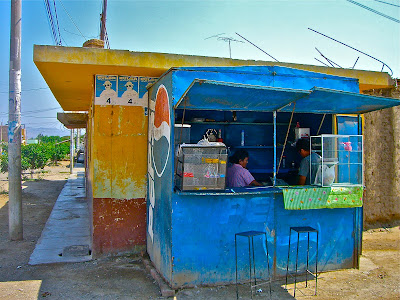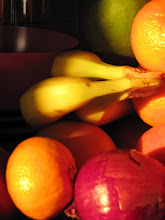I arrived in Pacasmayo the next morning, got on a van packed full with 21 people, some livestock and 2 bags of rice that brought me to the intersection of the Panamerican Highway and San Jose (see photo) where I met up with Joel.
From San Jose we had to take a motortaxi 

to another town where I met Joel's first sister, tending her Kiosk, feeding me papaya juice and tallarín (spaghetti).

With some carbs in our stomachs we made for the house of Joel's other sister, who lent us a bike, and then to the family of the sister who owns the kiosk to find a second one.  From there we headed out on a 40-minute journey over dirt road, bridges, fields, mud and watering channels, finally arriving in Santonte, where his parents and some other family members live. The "town" consists of two parallel roads, with about 20 houses in total. The houses face the massive plane of rice and onion fields, while enormous sand dunes and rocky mountains loom behind the town:
From there we headed out on a 40-minute journey over dirt road, bridges, fields, mud and watering channels, finally arriving in Santonte, where his parents and some other family members live. The "town" consists of two parallel roads, with about 20 houses in total. The houses face the massive plane of rice and onion fields, while enormous sand dunes and rocky mountains loom behind the town:
 From there we headed out on a 40-minute journey over dirt road, bridges, fields, mud and watering channels, finally arriving in Santonte, where his parents and some other family members live. The "town" consists of two parallel roads, with about 20 houses in total. The houses face the massive plane of rice and onion fields, while enormous sand dunes and rocky mountains loom behind the town:
From there we headed out on a 40-minute journey over dirt road, bridges, fields, mud and watering channels, finally arriving in Santonte, where his parents and some other family members live. The "town" consists of two parallel roads, with about 20 houses in total. The houses face the massive plane of rice and onion fields, while enormous sand dunes and rocky mountains loom behind the town:This orange house belongs to Joel's parents. Behind it you will find an outhouse, a sheep, 14 ducks, 2 guinea pigs, and the occasional baby cat, looking desperately for food.

 This is Joel's father who despite being 75 years old and having knee problems, would rather keep living in this town than move to an area where a food is readily available at supermarkets rather than still alive in the backyard and in need of being planted and harvested. Life has really treated his face well though, I think.
This is Joel's father who despite being 75 years old and having knee problems, would rather keep living in this town than move to an area where a food is readily available at supermarkets rather than still alive in the backyard and in need of being planted and harvested. Life has really treated his face well though, I think.After resting a few minutes after our bike ride, Joel and I headed out into the desert:

 The view was absolutely beautiful, the sand steaming hot and the wind "rico." After about a 30 minute treck in the heat, we made it into the forest where a lovely lagoon is hidden in the trees
The view was absolutely beautiful, the sand steaming hot and the wind "rico." After about a 30 minute treck in the heat, we made it into the forest where a lovely lagoon is hidden in the trees

 The view was absolutely beautiful, the sand steaming hot and the wind "rico." After about a 30 minute treck in the heat, we made it into the forest where a lovely lagoon is hidden in the trees
The view was absolutely beautiful, the sand steaming hot and the wind "rico." After about a 30 minute treck in the heat, we made it into the forest where a lovely lagoon is hidden in the treesThe water was warm and the little beach, though filled with dry cow-patties, excellent for taking a nap.


To quench our thirst we ate some super delicious guanabana. I know it doesn't look like anything yummy, but believe me that this juicy flavor combination of lychee, pineapple and grape was the most amazing thing.


On our way back we met a group of moo-ing cows.
The next day was also adventure-filled.
Joel's second cousin Lucho met us in the morning carrying a small basket full of little rocks and a rubber sling. I was left in the dark as to what we were going to do and just followed them into the desert, taking pictures of the scenery. On our way we were met by a 9-year old boy with blonde hair, thusly named "gringo." His face lit up immediately as he saw us coming and after running towards us he proudly reached into his pocket and pulled out two dead lizards ("cañanes"). "I already killed two big ones," he declared with a sparkle in his eyes and together with him and another young man that found us, we went further into the dunes to hunt lizards for lunch.
His face lit up immediately as he saw us coming and after running towards us he proudly reached into his pocket and pulled out two dead lizards ("cañanes"). "I already killed two big ones," he declared with a sparkle in his eyes and together with him and another young man that found us, we went further into the dunes to hunt lizards for lunch.
 His face lit up immediately as he saw us coming and after running towards us he proudly reached into his pocket and pulled out two dead lizards ("cañanes"). "I already killed two big ones," he declared with a sparkle in his eyes and together with him and another young man that found us, we went further into the dunes to hunt lizards for lunch.
His face lit up immediately as he saw us coming and after running towards us he proudly reached into his pocket and pulled out two dead lizards ("cañanes"). "I already killed two big ones," he declared with a sparkle in his eyes and together with him and another young man that found us, we went further into the dunes to hunt lizards for lunch. They often hide in these thorny trees whose dead branches on the ground make for some mean cuts on the bottom of your feet--the spikes are so sharp and long that they penetrate your shoe sole and can inflict some serious pain. The lizards hiding in the trees will often leap off the branches in a near-suicidal fashion, trying to avoid the rocks that are being catapulted at them. Once hit, the hunter will collect the animal and hit its head against a branch to make sure that it's dead.
They often hide in these thorny trees whose dead branches on the ground make for some mean cuts on the bottom of your feet--the spikes are so sharp and long that they penetrate your shoe sole and can inflict some serious pain. The lizards hiding in the trees will often leap off the branches in a near-suicidal fashion, trying to avoid the rocks that are being catapulted at them. Once hit, the hunter will collect the animal and hit its head against a branch to make sure that it's dead.

We spent about 2 hours in the midday heat and just walking around to follow the guys on their hunt was exhausting. In the end they caught 12 lizards, which when prepared as a ceviche with potatoes fed 6 people.

I wasn't there to see how the lizard was cooked because one of the neighbors prepared the dish. The meat itself didn't really have much flavor, but it was crunchy because the bones are left inside which allows for an interesting texture. It really just tastes like spicy onions and lemon juice--pretty good. But the whole experience of getting back from the walk and sitting on the side of the road with friends, family and neighbors, sharing stories and later lunch was a really exceptional one. Being the only foreigner this town has seen in a long time was apparently really exciting for the inhabitants and not much unlike a circus freak attraction, people would come by, look at me and timidly ask me a question about life in Germany and the United States. Being the center of attention was a bit exhausting at times and sometimes I just want to blend in or be invisible. The same happened to me when I was the foreign new kid at my high school, which resulted in my assimilating enough not to stick out. When I feel like that, though, I just remember that this is a once-in a life time experience and I will soon enough be invisible in the streets of New York again. There lies a certain comfort in that thought.


























